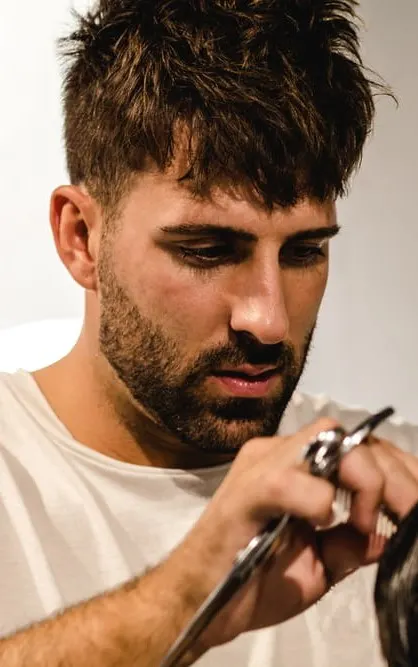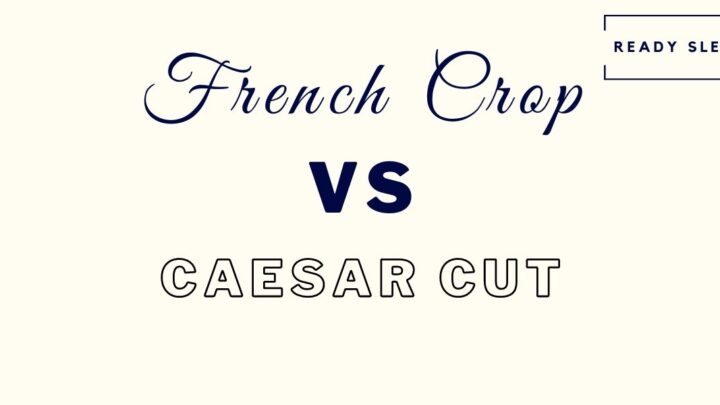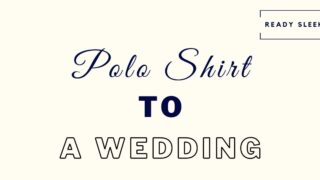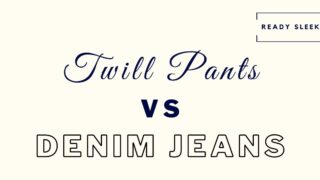There are certain styles that are so similar that you wonder why they’ve even got different names. These two may be similar, but they’ve got some pretty important differences. So, what’s the difference between a French Crop and a Caesar Cut?
The main difference is that Caesar Cuts have shorter and often blunter fringes than French Crops. The sides are clipped shorter than the top in both styles, but the contrast in length between the top and the sides is often greater with French Crops.
Although that’s the gist, let’s dig a little deeper. You’re about to learn more about the key differences between these two classic styles, as well as how to choose between them.
French Crop Vs Caesar Cut: 3 Key Differences
Their main similarities are that they’ve both got fringes and the sides are clipped shorter than the top.
But understanding the differences is the first step to helping you choose between them.
1. Fringe Length
“Fringes” are also known as “bangs”. It refers to the hair that falls forward over the frontal hairline and onto the forehead.
Both French Crops and Caesar Cuts are best known for their fringes.

Image From Shutterstock
In both styles, you’ve got one and they form the centerpoint of the styles themselves.
But the main difference lies in the length.
French Crops have longer fringes than Caesar Cuts. The exact lengths can definitely vary. There’s no single “point” beyond which a Caesar Cut becomes a French Crop.

From Deposit Photos
But in general, a good rule of thumb would be that if a fringe covers around half of the forehead (or more), there’s a good chance it’s long enough to be considered a French Crop.
That’s not a hard and fast rule, especially considering there are other differences between the two styles you need to consider (as you’ll soon see), but it’s something to bear in mind.
2. Fringe Edge
Fringes can be cut bluntly (i.e straight), in an arc shape, or ragged.
Both French Crops and Caesar Cuts are often cut with blunt and relatively straight fringes. It’s one of the things that makes them so eye-catching.
But in general, Caesar Cuts are often cut even blunter or straighter than French Crops.
One of the main reasons for this is that the hair is simply shorter. There’s simply less you can do with it.
It’s often not long enough to really snip it in an arc shape or ragged – even when you try, it’s so short that it ends up looking blunt and straight in any case.
French Crops are long enough to be a little more creative with the fringe. You could make it more jagged, textured, or arc-like.
3. Sides
This difference is the least important because there are plenty of examples to break the rules.
But in general, with French Crops, there is more of a length contrast between the hair on top and the sides.
While both Caesar Cuts and French Crops both feature long hair on top and short, clipped hair on the sides, the difference in length is usually more noticeable with a French Crop.
This isn’t always the case, however. Here’s an example of a style that’s clearly a French Crop where the sides aren’t that much shorter than the top:

But in general, with most French Crops, you can expect the contrast between the top and the sides to be a little more obvious when compared with a Caesar Cut.
French Crop Vs Caesar Cut: How To Choose
Now that you know the main differences between these two titans of men’s hairstyles, consider these factors when choosing between them.
1. Receding Hairline
This is an important one to consider.
French Crops are great for men with receding hairlines. The reason for this is that the fringe is usually long enough to cover the receding temples.
With Caesar Cuts, the fringe isn’t usually long enough to be useful in this respect.
You may get some coverage, but not as much as you’d get with the longer fringe of the French Crop.
There are plenty of men out there with receding hairlines who don’t really care – that’s fine. Embracing baldness is the best route you could possibly take.
But if you’ve got a receding hairline and wouldn’t mind making it a little less noticeable, consider the receding French Crop over the Caesar Cut.
Both Caesar Cuts and French Crops often feature high fades. These are often great for men with receding hairlines because the high fade usually makes a receding hairline look less noticeable.
It’s almost as though it absorbs the receding hairline and makes the receding temple simply appear as though it’s part of the high fade.
The shorter the fade the better – skin fades would make it most effective but it’s obviously a pretty bold and in-your-face feature.
That’s just a side note however, as both French Crops and Caesar Cuts can feature high fades it doesn’t really help you decide.
It’s really the fringe length that should influence you either way when you’ve got a receding hairline.
2. Maintenance
Caesar Cuts are easier to maintain and style than a French Crop.
Having a long fringe isn’t as easy as it may seem at first. You need to take care of it.
The fringe of a Caesar Cut is so short that there’s really not a huge amount you can or need to do with it.
You don’t usually need to worry about building texture or styling it at all. You could apply a bit of styling product to the top hair but the hair will usually be short enough to keep tidy on its own.
French Crops are known for having longer hair on top and longer hair falling forward onto the forehead.
This takes a little more time and effort to keep looking neat and stylish.
You probably won’t need to do that much with it, considering you’re just laying it down flat and forward.
But you’ll need to do more with it than you would with a Caesar Cut. A little more washing, a little more product, and so on.
If you’d prefer a lower-maintenance style, the Caesar Cut may be a better option for you than the French Crop.
3. Face Shape
Both French Crops and Caesar Cuts are best suited to people with longer face shapes such as oblong, oval, rectangular, or diamond.
The reason for this is that the styles are flat. You aren’t adding any sort of height up top as you would in the form of a quiff or a pompadour, for instance.
In addition, they also shorten the face itself by simply covering up some (or even most) of the forehead.
Given how French Crops have longer fringes, they actually shorten the face more than Caesar Cuts do.
If you’ve got a “longer” face shape and you’re looking to make it shorter or more balanced, a long fringe may be exactly what you need. This is where a French Crop could benefit you.
If you’ve got a face shape like this but you aren’t looking to shorten it that much, a Caesar Cut would probably be a better option.
While face shape is important, don’t put too much thought into it.
If you simply like the way one of these styles looks on you more than the other, there’s a good chance it suits your face shape better.
You may not have even really thought that much about it, but just came to the decision naturally.
But if your face shape is pretty obvious, it’s definitely worth thinking about before you make your decision.
Conclusion
There you have it. Two fantastic styles with some incredible similarities but very important differences as well.
Hopefully, you now have a much better idea of how they’re different and can use that information to guide your decision-making.
Enjoy.
Ready Sleek founder. Obsessed with casual style and the minimalist approach to building a highly functional wardrobe. Also a fan of classic, vintage hairstyles.







